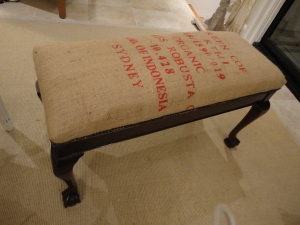I’m really excited about this project – converting a somewhat dilapidated bench into the ultimate in organic chic….
Here it is ‘before’. The padding and the fabric had pretty much disintegrated.
The first thing to do is strip it right back. As I took the fabric off, it became apparent that all the padding underneath was absolutely shot. (revolting actually!)
So I took it right back to its bare bones – which are very beautiful.
Then I needed to prepare some more padding. In a stool like this, horsehair was the old-fashioned filling. I’m not really a purist (in case you haven’t guessed) so I’m happy to use modern technology where it suits – and high quality foam inserts work beautifully here.
The tricky part is actually cutting this stuff. The best way I’ve found is to use an electric carving knife! Most places that you buy this will cut it to size – but I have a stash of it, so needed to cut it myself. I wanted to make this a more luxurious piece, so I used a thicker foam than was in the original (about three times times thicker!).
This is then placed on the stool, and wadding added to soften the edges. Usually you’d put a calico cover on, but I prefer to use up material left over from previous projects (re-use etc) so this lucky stool got it’s ‘calico’ coat made out of beautiful gold stripe!
Putting this layer on will make the top fabric sit much better. Although when I went to find what I wanted to use, I thought – maybe I’d better come back later?
Then I remembered it is ‘Let sleeping DOGS lie’ and it doesn’t say anything about cats…. Poor Diesel.
A carefully sourced vintage (organic!) coffee sack is to be the final cover. I’m sure I’m just going to love the texture of the bag against the smooth polished mahogany of the antique legs. Incidentally – don’t you just love those ball and claw feet? (the stool – not the cat!)
The edges were trimmed with studs to finish it off.
With this type of very thick fabric, the only way to get the corners really crisp is to hand sew them. It’s worth it – they sit much better for some stitching.
This stool has a storage compartment inside – the lid lifts up on hinges – which makes it even more handy.
This item will be for sale, when I get around to that.
Do send in before and after photos of your recycled furniture – and share your experiences.






































